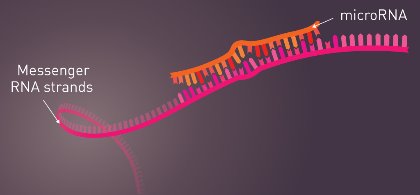Sep. 19, 2014 Research Highlight Biology
The constant nibble that keeps cancer at bay
An enzymatic pathway that destroys a tiny RNA molecule helps keep cancer and other diseases linked to cell proliferation in check
 Figure 1: MicroRNAs are short, non-protein-coding RNA molecules that contain base-pair sequences that are complementary to their target messenger RNA molecule. Once bound together, the microRNA can cause the messenger RNA to break down. Modified from miRNA and licensed under CC BY 3.0 via Wikimedia Commons © Kelvinsong
Figure 1: MicroRNAs are short, non-protein-coding RNA molecules that contain base-pair sequences that are complementary to their target messenger RNA molecule. Once bound together, the microRNA can cause the messenger RNA to break down. Modified from miRNA and licensed under CC BY 3.0 via Wikimedia Commons © Kelvinsong
MicroRNAs, although tiny compared to their protein-coding messenger RNA counterparts, wield a powerful influence over the expression of a wide range of genes. These molecules bind to specific messenger RNAs that contain complementary nucleotide sequences (Fig. 1) and target them for destruction, thereby reducing the production of the messenger-RNA-encoded protein. Research led by Michiel de Hoon and colleagues from the RIKEN Center for Life Science Technologies has now revealed an unusual mechanism that controls the activity of the miR-21 microRNA, which is overexpressed in most cancers1.
The researchers initially set out to identify changes in the production of various microRNAs in breast cancer. During that investigation, however, co-author Joost Boele observed an unexpected alteration in the sequence at the end of the well-studied miR-21 molecule. “miR-21 is the most intensively researched microRNA due to its overexpression in most cancers,” explains De Hoon. “Sequence variations at the end of microRNAs have been observed previously but usually the extra nucleotide was an adenosine, whereas in our case it was a cytidine.”
Closer examination of breast cancer cells confirmed that they predominantly produced two different forms of miR-21: the previously identified miR-21 sequence, which contains 22 nucleotides, and the variant observed by Boele, known as miR-21+C, which includes an additional cytidine nucleotide. The researchers subsequently uncovered an enzymatic pathway that trims miR-21+C to produce miR-21, indicating that miR-21+C is in fact the starting material from which miR-21 is derived. This enzymatic pathway, which eventually leads to the degradation of miR-21, requires the action of two proteins: one tacks yet another nucleotide on to the end of miR-21+C and the other recognizes this addition and chews away at the RNA molecule.
This process proved to have important implications for cellular growth. In a comparative analysis between ten different tumor types and the normal tissues from which these tumors emerged, the researchers discovered that this miR-21 degradation pathway was consistently impaired in cancerous tissues. “This is a very general phenomenon in cancer,” says De Hoon.
The microRNA miR-21 is known to inhibit multiple genes that restrict cell division, which in part explains the importance of this microRNA in cancer. However, De Hoon and his colleagues also found reduced degradation of miR-21 in tissue samples for patients with psoriasis, a disease associated with abnormal growth of the top layer of the skin—a finding that further underscores the importance of this microRNA as a general controller of cell proliferation.
References
- 1. Boele, J., Persson, H., Shin, J. W., Ishizu, Y., Newie, I. S., Søkilde, R., Hawkins, S. M., Coarfa, C., Ikeda, K., Takayama, K. et al. PAPD5-mediated 3′ adenylation and subsequent degradation of miR-21 is disrupted in proliferative disease. Proceedings of the National Academy of Sciences USA 111, 11467–11472 (2014). doi: 10.1073/pnas.1317751111
